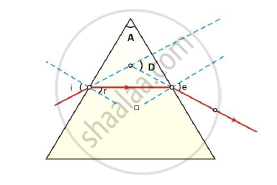Advertisements
Advertisements
Question
In the figure given alongside, a narrow beam of white light is shown to pass through a triangular glass prism. After passing through the prism, it produces a spectrum YX on the screen.
State the colour seen (i) at X, and (ii) at Y.
Solution
(i)The colour seen at X is violet (as it is the maximum deviated).
(ii) The colour seen at Y is red (as it is the least deviated).
APPEARS IN
RELATED QUESTIONS
In the following ray diagram the correctly marked angle are:

(a) ∠i and ∠e
(b) ∠A and ∠D
(c) ∠i, ∠e and ∠D
(d) ∠r, ∠A and ∠D
Out of the following, the colour of light having the maximum wavelength is:
(a) violet
(b) indigo
(c) green
(d) orange
In the spectrum of white light by a prism, the colour at the extreme end opposite to the base of prism is ______.
A glass prism is able to produce the spectrum when white light passes through it, but a glass slab doesn’t produce any spectrum. Explain why it is so.
If white light is used in same way what change is expected in the emergent beam?
A wave has wavelength 50Å of name the wave.
A student has to trace the path of a ray of light through a glass prism. List four precautions he should observe for better results.
Distinguish between an impure spectrum and a pure spectrum.
The splitting of white light in to seven colors is called ______.
Say TRUE or FALSE
After passing through a prism, white light splits into a band of seven colours
